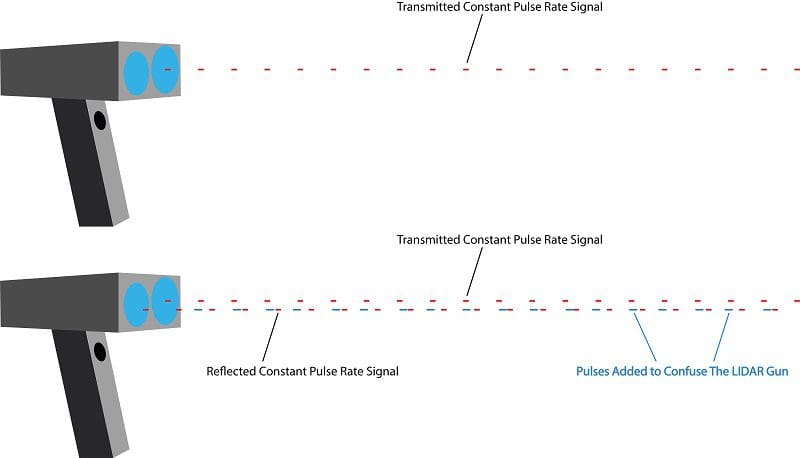Over the past few months, we’ve talked about how radar detectors and laser defense systems work. Now it’s time to talk about the dreaded and often controversial DragonEye ECCM-equipped lidar guns and why they’re so difficult to jam.
What Is DragonEye ECCM?
 Let’s break this down a bit. Based in Norcross, Georgia, DragonEye Technology is a company that develops electro-optical systems for the law enforcement industry. What does this mean? They make police lidar guns. They have two basic product categories: lidar speed measurement guns with and without a built-in camera.
Let’s break this down a bit. Based in Norcross, Georgia, DragonEye Technology is a company that develops electro-optical systems for the law enforcement industry. What does this mean? They make police lidar guns. They have two basic product categories: lidar speed measurement guns with and without a built-in camera.
Aside from the quality, accuracy and reliability of their products, DragonEye’s claim to fame is their anti-jamming technology called the Electronic Counter-Counter Measure (ECCM) system. ECCM was designed to prevent a conventional laser defense system from being able to disable DragonEye’s measurement system.
What Is ECCM?
In a conventional lidar gun, the emitting laser produces pulses of light and measures the time it takes for those pulses to be reflected back to the gun. Knowing the speed of light, the gun can calculate the speed of an object by analyzing the changes in reflection time for each pulse. For our discussion, let’s say that the gun sends out 150 pulses per second and expects to see that same frequency of pulses returned.

Laser defense systems on our cars and trucks are designed to detect these pulses of light and transmit additional pulses and varying timing patterns to prevent a lidar gun from being able to make a calculation.
When ECCM is in use, the spacing between the light pulses is somewhat random. We specify that is it only “somewhat” random because the gun needs to know when it emitted a pulse and be able to measure its reflection time. As such, there is a pattern, even though it’s complicated.
Again, purely as an example, a DragonEye Gun may start transmitting at 150 Hz (pulses per second), then ramp up to 1,500 Hz and back down.

Defending Against Variable Pulse Rate Lidar
A simpler name for lidar guns like the DragonEye Compact and DragonEye Speed LIDAR with ECCM enabled is Variable Pulse Rate (VPR) radar. Other guns like the Stalker X-Series, the Laser Ally lidar and the LTI TruSpeed also offer VPR anti-jamming modes.

It’s worth clarifying: It’s the frequency of the pulses that is changed, not the frequency or wavelength of the beam being transmitted. For most lidar guns, that beam remains in the 905 nanometer/331.26 terahertz range.
In order for your laser defense system to prevent a reading, the system needs to detect the algorithm used to modulate the laser pulse frequency and transmit a compatible yet scrambled pattern. The transmitted pulses can’t simply be random.

The Cat-and-Mouse Game
 Manufacturers of laser defense systems such as Escort, AL Priority, Stinger and K40 are constantly working on updating their firmware to maintain compatibility with new firmware from the lidar gun manufacturers. Statements about which defense systems defend against which guns should be qualified with confirmation of the firmware on the gun. A four-year-old DragonEye gun that has never had an update is going to be easier to jam than one that just came off the assembly line or has just returned from recertification and updates.
Manufacturers of laser defense systems such as Escort, AL Priority, Stinger and K40 are constantly working on updating their firmware to maintain compatibility with new firmware from the lidar gun manufacturers. Statements about which defense systems defend against which guns should be qualified with confirmation of the firmware on the gun. A four-year-old DragonEye gun that has never had an update is going to be easier to jam than one that just came off the assembly line or has just returned from recertification and updates.
If you are shopping for a laser defense system, visit your local specialist mobile enhancement retailer and talk with them about where and how you drive. If they are truly experienced in the laser defense market, they will be able to tell you what radar and lidar guns are in use in your area and help you select a solution that will meet your needs. As always, we want to remind our readers that the performance of a laser defense system depends significantly on the installation. A reliable and accurate installation isn’t cheap but it can be the difference between getting a speeding ticket and arriving at your destination without delays.

